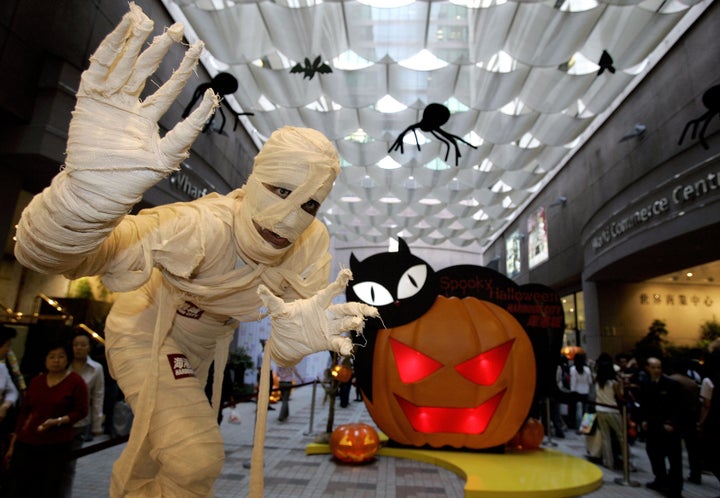
Americans love Halloween. We as a country spend over $5 billion a year celebrating it. But where did the holiday come from? And how did traditions like asking strangers for food and dressing up as ghosts develop?
Halloween has its roots in Samhain (pronounced sow-in), an ancient harvest festival held at the end of the Celtic year. The festival marked the end of summer and the beginning of the dark wintertime. It was believed the spirits of the dead returned on this eve to damage crops and play tricks on the living. It was also believed that the Celtic priests, or Druids, were able to make predictions about the future, which they did during large bonfire celebrations where they wore animal skins and sacrificed crops and animals to the spirits.
In early A.D., Romans came to the Celtic territories of modern day England, Scotland and Northern France, and were the first people to influence the celebration of Samhain. They brought their own holidays: Feralia, the Roman day to honor the dead in late October, as well as another holiday to honor Pomona, the Roman goddess of fruit and trees. It is possible that this Roman influence is the reason apples are given out and bobbed for on Halloween.
By 800 A.D., Christianity spread to the Celtic Territories and brought with it another holiday, "All Saints Day." Pope Boniface IV, the designator of All Saints Day, was likely trying to replace Samhain with a similar but holier holiday meant to honor saints and martyrs. Later on, All Saints Day was renamed "All Hallows" and thus the day of Samhain (Oct. 31st) began to be called "All Hallows Eve," and eventually shortened to "Hallowe'en."
All of the holidays that were melded together to create our modern version of Halloween involved dressing up in one way or another. The celebrators of Samhain wore animal skins at their bonfire celebrations and those that observed "All Saints Day" often dressed as saints or angels. Later on men in Scotland would impersonate the dead on the day, explaining the ghoulish tradition we still observe.
During the mid 1800's, Irish and English immigrants flooded the United States and brought Halloween with them. From these immigrants we received the Halloween traditions we recognize today, however skewed they are now. For instance, the first trick-or-treaters were far from today's smiling children with commercialized costumes. They lived in Medieval England, and practiced "souling," in which poor people would beg for sweet breads, in return for praying for the families' souls. Later, the immigrants who brought Halloween to America would develop their own version of trick-or-treating, but it didn't become popular here until the 1930s.
1) Halloween Is The Second Highest Grossing Commercial Holiday After Christmas
What used to be just a singular holiday with minimal things to purchase has turned into an entire "Halloween Season." Between decorative lights and lawn ornaments, elaborate costumes and loads of candy, the average American spends a pretty penny on this fall holiday. However popular Halloween has become, the recession has affected spending for this year's spooky night. Spending is down, according the the National Retail Federation. Shoppers will spend an average of $56.31 on the holiday compared to $66.54 in 2008. Some ways people are cutting down include making homemade costumes, using last year's decorations and buying less expensive candies. For the children's sake, let's hope everyone doesn't resort to giving out apples and pennies. Didn't you just hate that as a kid?
2) Harry Houdini Died On October 31, 1926
The famous magician was killed (accidentally) by a McGill University student named J. Gordon Whitehead who was hitting him in the stomach repeatedly as part of a stunt. A week later he died of peritonitis from a ruptured appendix. Despite acute appendicitis, Houdini refused to seek medical treatment.
3) There's A Phobia For That
Samhainophobia is an intense and persistent fear of Halloween that can cause panic attacks in sufferers. Other relevant phobias for this time of year: wiccaphobia (fear of witches), phasmophobia (fear of ghosts), and coimetrophobia (fear of cemeteries).
4) The First Jack-O-Lanterns Weren't Made Out Of Pumpkins
They were originally hollowed-out turnips. The modern practiced mutated from the Irish tradition of carving faces of the the dead onto the gourds and putting candles inside to make them glow. These days your Jack-O-Lantern is most made out of a pumpkin, which most likely came from Illinois--a state that grew 542 million pounds of pumpkin in 2007.
5) One Quarter Of All The Candy Sold Annually Is For Halloween Night
Yes, no matter how much we eat for Christmas and Thanksgiving, Halloween has corned the market on candy. As a country we consume 20 million pounds of candy corn a year. Handing out Halloween treats is the perfect excuse to eat some too, as four-in-ten (41%) adults admit that they sneak sweets from their own candy bowl. And if you're a kid, hang on to your basket, because home is where the candy thief is as 90% of parents admit to sneaking goodies from their kids' Halloween trick-or-treat bags. But whether your stealing some, handing out some or having yours stolen, chances are you'll get your hands (or miss getting your hands) on a Snickers bar, it has been the number 1 Halloween candy for years.